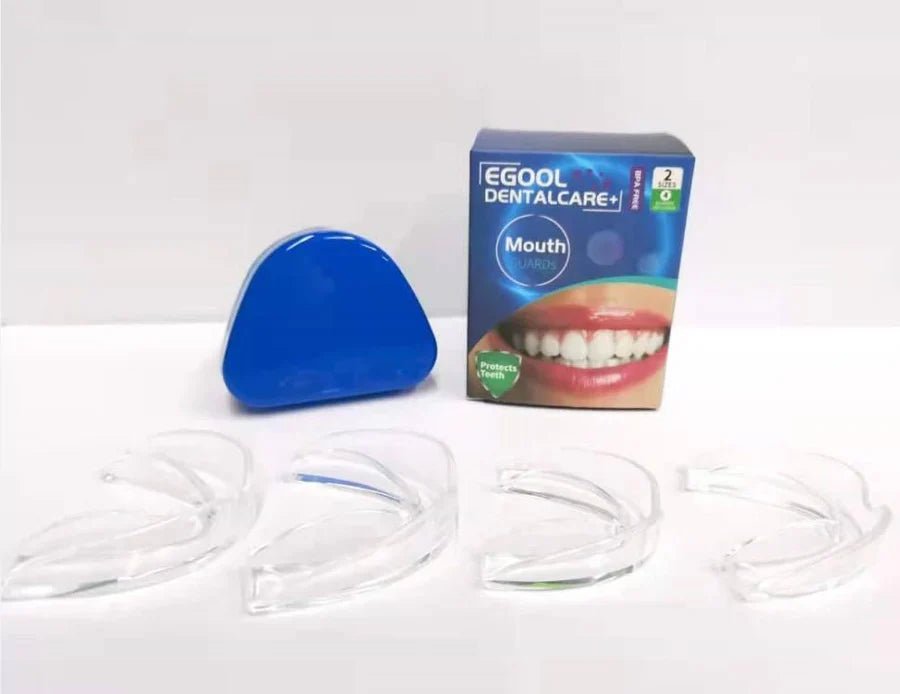Using a mouth guard is one of the smartest ways to protect your teeth from grinding, clenching, and nighttime damage.
But just owning a mouth guard isn’t enough.
How you use and care for it can make the difference between effective protection and wasted money—or worse, harming your oral health.
Let’s dive into the 7 most common mistakes people make with their mouth guards—and how you can easily avoid them.
Mistake 1: Not Cleaning Your Mouth Guard Daily
Why it's a problem:
Mouth guards sit in a warm, moist environment (your mouth) that’s perfect for bacteria to thrive.
If you don’t clean your guard after each use, bacteria can build up quickly, causing:
-
Bad breath
-
Oral infections
-
Gum irritation
How to avoid it:
Rinse your mouth guard with warm water every morning. Gently brush it with a soft toothbrush (without toothpaste) and let it air dry before storing it.
Mistake 2: Using Toothpaste to Clean Your Mouth Guard
Why it's a problem:
Toothpaste may seem like a logical choice, but it’s too abrasive for mouth guard materials. It can scratch the surface, creating tiny grooves where bacteria can hide.
How to avoid it:
Clean your bruxism mouth guard using mild, unscented soap or a denture-cleaning solution once a week.
Stick to gentle cleaning methods to preserve its smooth surface.
Mistake 3: Storing It While Wet
Why it's a problem:
Bacteria love moisture.
If you store your mouth guard wet inside a closed case, you’re creating a breeding ground for mold and bacteria.
How to avoid it:
Always dry your mouth guard completely before placing it in its ventilated storage case.
Allowing proper airflow keeps it fresher for longer.
Mistake 4: Ignoring Signs of Wear and Tear
Why it's a problem:
Over time, even the best mouth guards start to wear down.
If you keep using one that’s cracked, torn, or misshapen, it won’t protect your teeth properly—and could even irritate your gums or cheeks.
How to avoid it:
Replace your night mouth guard every 6 to 12 months or sooner if you notice visible damage.
Signs it's time to replace:
-
Cracks or tears
-
Loss of fit
-
Persistent bad odor after cleaning
-
Discoloration
Mistake 5: Choosing the Wrong Type of Mouth Guard
Why it's a problem:
Not all mouth guards are created equal.
Choosing a poor-fitting, uncomfortable mouth guard can lead to poor compliance—you might stop wearing it altogether.
How to avoid it:
Choose a boil-and-bite mouth guard if you want an affordable, customizable fit at home.
Custom-fitted guards from dentists offer premium comfort but are more expensive.
Tip:
If you can’t talk or breathe easily with it in, it’s too bulky.
Comfort = consistency.
Mistake 6: Not Remolding When Necessary
Why it's a problem:
Over time, dental changes (like shifting teeth or dental work) can make your mouth guard fit poorly.
How to avoid it:
Many boil-and-bite mouth guards allow you to remold them several times.
If the fit feels off, simply reheat and remold according to the instructions to maintain protection and comfort.
Mistake 7: Only Wearing It Sometimes
Why it's a problem:
Inconsistent use defeats the purpose of protecting your teeth and jaw.
Grinding and clenching can happen anytime you sleep, not just occasionally.
How to avoid it:
Make wearing your sleep mouth guard a nightly habit.
Place it next to your toothbrush as a visual reminder, or keep your case on your nightstand.
Bonus Tip: Bring Your Mouth Guard to Dental Check-Ups
Did you know your dentist can help evaluate your mouth guard’s fit and condition during regular check-ups?
Bringing it to your appointment ensures you get professional advice on whether it’s still doing its job properly.
FAQs About Using Mouth Guards
Q: Can I wear a mouth guard with braces?
A: Yes, but you’ll need a special guard designed for orthodontic work.
Q: Should I wear my mouth guard during the day?
A: If you clench your teeth while awake (known as awake bruxism), a daytime mouth guard can help.
Q: What if my mouth guard feels uncomfortable?
A: Re-mold it (if it’s boil-and-bite) or consider upgrading to a better-fitting model.
Final Thoughts
A mouth guard for sleeping is one of the easiest, smartest ways to protect your teeth, jaw, and overall oral health.
But like any tool, it only works if you use and care for it properly.
Avoiding these common mistakes ensures your mouth guard stays clean, comfortable, and effective—giving you peace of mind every night.
🦷 Protect your smile the smart way! Shop our high-quality Mouth Guards today for the comfort, durability, and protection you deserve. Sleep better, wake up happier! 🦷

